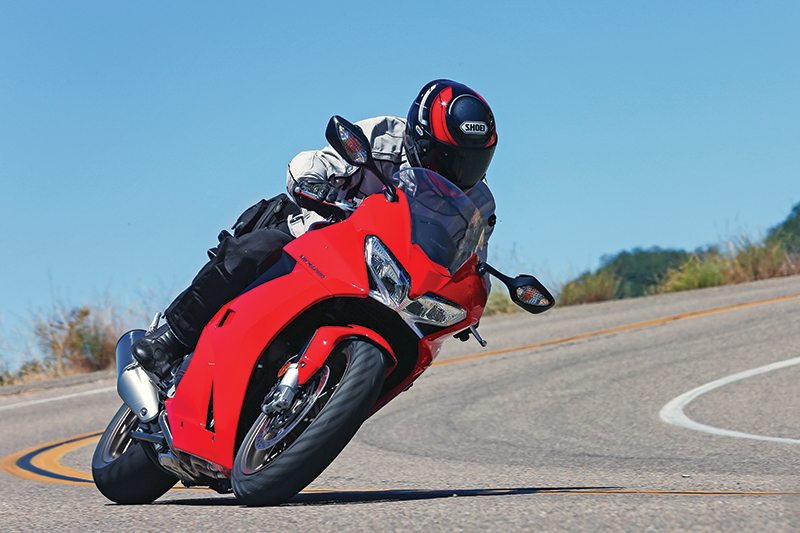
Honda has unleashed so many new motorcycle models recently that one wonders where dealerships are going to put them all. The company is on a mission to convert flocks of the uninitiated into happy motorcyclists. As a result many of its new bikes—NM4, NC700, CTXs, etc.—have unorthodox styling and very beginner-friendly features and states of tune. In fact, at their press introductions we’re often reminded that these motorcycles are “not for us,” meaning not for the journalists in attendance, who tend to be veteran enthusiasts with more traditional tastes.
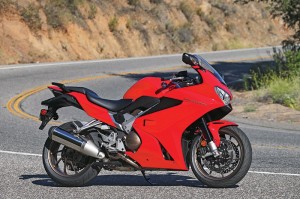
We got no such reminder at the launch of the new Honda VFR800 Interceptor, which is back for 2014 to help fill the gap between hard-edged sportbikes and heavier sport-touring machines. Last seen for 2009, the VFR800 is still right up our alley, a classic enthusiast’s sport and sport-touring motorcycle that strikes just the right balance for many riders among performance, handling and comfort. Now it has more of all three.
At the heart of the Interceptor is the liquid-cooled, 90-degree V-4 that has its roots in the first modern superbike, the 1983 VFR750F Interceptor, and has received continuous refinement since, including the watershed VFR800FI for 1998. For its last major makeover in 2002, Honda finally copped to the bike’s sport-touring role by offering optional hard saddlebags. Silent-type chains replaced the gears driving the dual overhead camshafts, updates were made to the fuel injection, ignition, cooling systems and clutch, and the angular styling took a turn away from the sexy NR750-like appearance of the 1998 model.
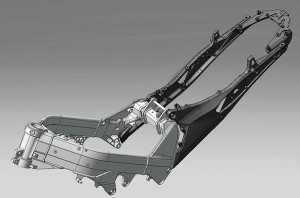
The bike also gained about 38 pounds with a larger fork, fuel tank, fairing and windscreen, longer single-sided swingarm and optional ABS. This was also the year the Interceptor added VTEC, or Variable Valve Timing and Lift Electronic Control, which broadened the powerband by keeping two of the four valves closed until 7,000 rpm, when the other two open with a surge of power. VTEC had its share of detractors who felt the transition was too abrupt, especially when it occurred in corners.
Honda gave the 2006 VFR800 a few styling tweaks and softened the VTEC transition slightly by lowering the point at which it occurred to 6,400 rpm, but that wasn’t enough to keep the bike from going away after 2009 for a complete rehab. At first blush the 2014 model doesn’t seem all that different, but a closer look reveals that Honda has been just as busy with the Veefer as it has with its other new bikes.
Instead of flanking the engine the two radiators are stacked in front now, allowing Honda to narrow the newly styled fairing by 1.5 inches, and it feels like a lot more from the saddle. Note the return of the NACA duct from the 1998 model in the back of the fairing, too. Both the taillight and catty new X-shaped headlight with accent lights are LED, and the front turn signals were moved into the mirrors. Wheels are new 10-spoke fine-cast items with a special bronze finish that is shared by several engine covers and the handlebar, and the new instrument package features a central tachometer flanked by digital displays including a gear-position indicator, MPG readout, ambient air temperature gauge and clock. Riders can still swap the pillion seat and grab rails for the included solo seat cover, which creates some storage space underneath.
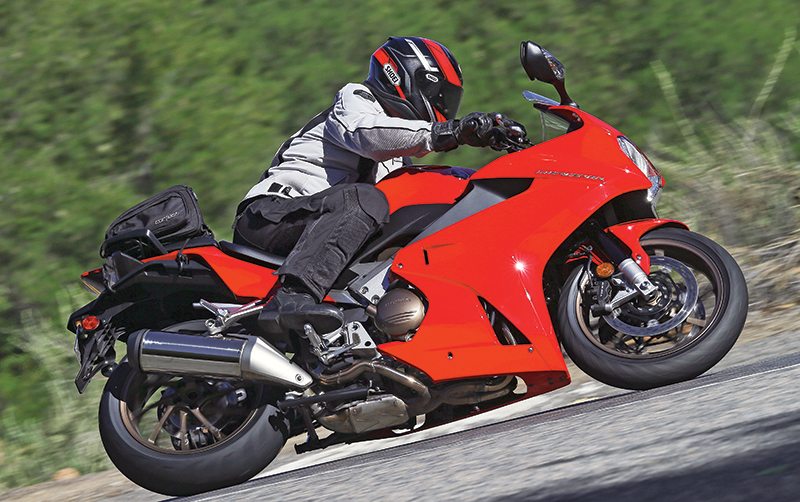
For many VTEC will only be a plus when it becomes undetectable, so Honda put an emphasis on low to midrange torque in the 2014 model and further tweaked the cam timing and VTEC settings to make the surge of power more linear—nearly undetectable—except for the wail coming from the airbox when all four valves begin to open. Other changes like longer intake funnels, revised exhaust ports and a lighter, shorter new 4-2-1 exhaust contribute to a nice bump in torque output between 3,400 rpm and 6,400—where VTEC begins to kick in—and smoother power curves. On the Jett Tuning dyno the 2014 Interceptor made 98.3 horsepower peak at the rear wheel at 10,000 rpm (about 700 rpm lower than our last test bike—redline is at 12,000) and 54 lb-ft of torque at 8,400, with more than 80 percent of it on tap from 3,400 to 11,300 rpm.
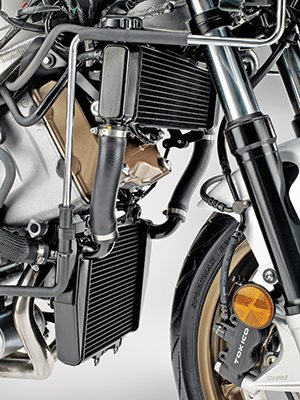
This broad spread of power makes the VFR extremely easy to ride down low, around town and in tight canyons where you can pretty much leave it in third gear, yet it has plenty of kick on top for sheer speed. The engine still offers that wonderful ripping-velvet feel typical of the Honda V-4, though it could use a little more tone from the exhaust to complete the sensation. The bike runs on regular gas, and its good fuel economy gives it great range from the 5.6-gallon tank. It shifts like a Swiss watch too, with smooth, linear clutch engagement, and this year Honda offers an optional quick shifter.
Chassis improvements include a lighter new cast-aluminum subframe that replaces the former steel tube design, and a redesigned Pro-Arm single-sided swingarm with a cast-in brace. It still pivots off the back of the engine rather than on the twin-spar aluminum frame for better ride comfort and handling. The sporty seating position is relatively unchanged, with footpegs that are high and rearset, and hand grips that are low and close together but well above the triple clamp instead of below. At five-foot, 10 inches tall with a 29-inch inseam I found the bike reasonably comfortable on long rides; taller riders might experience less weight on their wrists but more leg bend. The new adjustable seat has almost 3 inches of padding and is narrower in front, so even with it in the higher position I could easily plant both feet on the ground at stops, and it can be lowered (with a hex wrench and some patience) about .8 inch.
For the first time Honda will offer bar risers for the Interceptor that raise the grips about .5 inch and move them back about .25 inch, and I would definitely get them along with the optional larger windscreen to potentially cut down on wind noise. Long-distance riders will also want to opt for the Interceptor DLX model, which adds heated grips, a centerstand, self-canceling turn signals, traction control you can turn off and ABS brakes, plus damping adjustability for the cartridge fork and a remote rear spring preload adjuster. Many of these things are optional on the base model as well, along with a color-matched, 33-liter top trunk, rear carrier and locking hard saddlebags, the mounts for which are nicely integrated into the tailsection now.
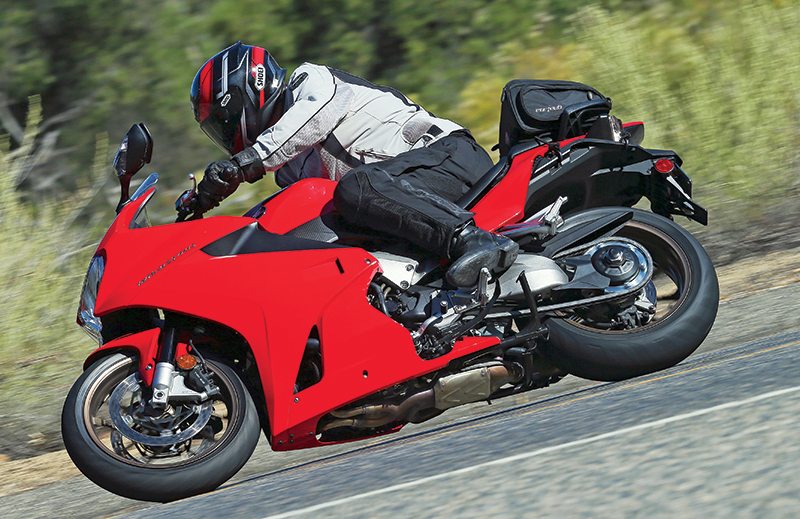
The effort Honda has made to shave weight from the VFR’s exhaust and chassis has paid off, as our DLX weighed 23 pounds less than our last Interceptor ABS test bike. Additional weight savings took place in the more compact and centralized ABS on the 2014 DLX model, and Honda also went back to unlinked brakes this year. The triple discs with new radial-mount calipers up front stop the bike incredibly well, and both the front brake and clutch levers are adjustable.
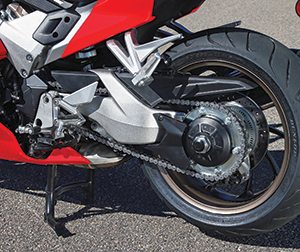
If I had a gripe about the 2014 Interceptor DLX it would be with the suspension, which can’t be softened-up enough in back for solo commuting in comfort. The comfortable seat helps, but even with the preload backed off all the way and the rebound damping set to light, the bike pounded me on some our bumpy freeways and backroads. It works quite well for sport riding of course, and complements the bike’s precise handling with terrific compliance and control, but some more range on the soft side would be appreciated.
Otherwise, no matter where you ride the Interceptor, it works very well—like the Ginsu knife of motorcycles, whether it’s blitzing through the canyons or slogging the freeway up to the races. This is a touring guy’s sportbike and a sportbike guy’s touring machine, with plenty of power and handling for sport riding, even the occasional track day, and satisfactory comfort for sport touring. It shows that Honda’s core competency is still building motorcycles that veteran enthusiasts can appreciate, bikes that are most definitely “for us.”
(This article Core Competency was published in the September 2014 issue of Rider magazine.)
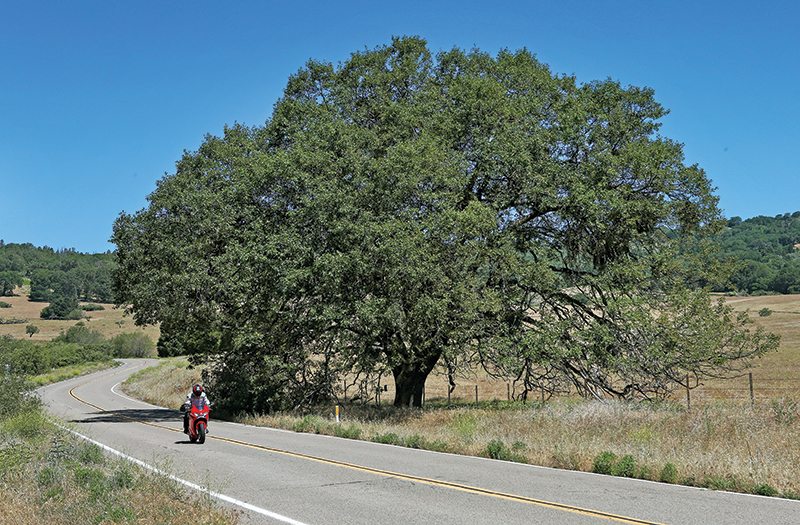
2014 Honda Interceptor/DLX
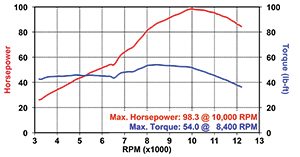
Base Price: $12,499
Price as Tested: $13,499
(DLX model)
Warranty: 12 mos., unltd. miles
Website:
powersports.honda.com
Engine
Type: Liquid-cooled, transverse 90-degree V-4
Displacement: 782cc
Bore x Stroke: 72.0 x 48.0mm
Compression Ratio: 11.8:1
Valve Train: VTEC DOHC, 4 valves per cyl.
Valve Insp. Interval: 16,000 miles
Fuel Delivery: PGM-FI w/ automatic enrichment, 36mm throttle bodies
Lubrication System: Wet sump, 3.3 qt. cap.
Transmission: 6-speed, hydraulically actuated wet clutch
Final Drive: O-ring chain
Electrical
Ignition: Digital transistorized w/ electronic advance
Charging Output: 420 watts @ 5,000 rpm
Battery: 12V 11AH
Chassis
Frame: Cast aluminum box-section twin-spar w/ engine as stressed member & cast aluminum engine-mounted single-sided Pro-Arm swingarm
Wheelbase: 57.5 in.
Rake/Trail: 25.5 degrees/3.74 in.
Seat Height: 31.0/31.8 in.
Suspension, Front: 43mm male slider, adj. for spring preload & rebound damping (as tested) w/ 4.3 in. travel
Rear: Pro-Link single shock, remotely adj. spring preload (as tested) & rebound damping w/ 4.7 in. travel
Brakes, Front: Dual floating 310mm discs w/ radial-mount opposed 4-piston calipers & ABS (as tested)
Rear: Single 256mm disc w/ 1-piston caliper & ABS (as tested)
Wheels, Front: Cast, 3.50 x 17 in.
Rear: Cast, 5.50 x 17 in.
Tires, Front: 120/70-ZR17
Rear: 180/55-ZR17
Wet Weight: 532 lbs. (as tested)
Load Capacity: 392 lbs. (as tested)
GVWR: 924 lbs.
Performance
Fuel Capacity: 5.6 gals., last 1.0 gal. warning light on
MPG: 86 PON min. (low/avg/high) 42.9/45.6/48.5
Estimated Range: 255 miles
Indicated RPM at 60 MPH: 4,250

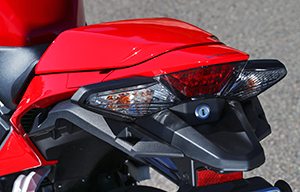
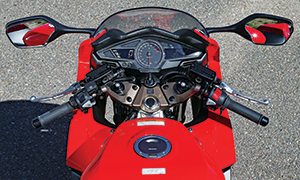








The good news is that I can replace my 2002 Interceptor, if I was of a mind to and know that I’m not losing anything. The bad news is I don’t have a compelling reason to do so for a while because there isn’t that much to gain.
Hard to imagine why I would sell my 1999 for this bike. More HP no unnecessary VTEC and a similar appearance. Recent upgrades to the suspension on my current bike cost 2K and provide more adjustability front and rear. Be interesting to see a comparison between an updated 1998-2000 and the new offering. My bet: shopping for a low mileage non-VTEC and upgrading the suspension provides a better bike for 6-8K less.
Just my $.02 worth
I am sure someone who had the previous model to yours would have said the same thing, all VFR’s seem to be well regarded so until you are no longer happy with your model you made the right choice (for you) I will say the same thing when the next model is released. It may be unnecessary but boy do I love the Vtec
Yeah, I doubt it. I’ve got a 2015 model and its outstanding. I like it better than any of the older models I’ve ridden.
I went to a 2009 Yamaha FZ1 from a beloved 1998 VFR. Although it was more comfortable, about the same weight, 30 more hp and more torque, it always felt like a downgrade in quality and engine characteristics. Is the new 2014 enough to return me to the VFR fold? We’ll see! At its list price it is very close to the basic FJR1300, which is probably what I really need, since I am now 16 years older than when I got the ’98 VFR800!
I agree with Brian. It’s great that Honda brought back this iconic all-arounder. My 2003 abs model doesn’t have LED’s or the shiniest paint anymore; however for me, without a compelling reason to buy a new VFR like increased power or an improved long-range riding position, I may be spending some serious cash for only a marginally better ride. And, with 109 horses on tap in my ’03, in one category at least, a down grade. Honda is, I’m sure, looking to bring a lot of new riders into the venerable VFR 800 fold. For current owners like me hoping to improve on our aging VFR’s, though, we may find our next bike at the FJR, 1300S, or K1000 stores.
I have been out for a test ride on the ’14 VFR and I loved it. Coming from a straight twin the engine is silky smooth. I didn’t notice any change at the VTEC point other than the exhaust note getting throatier and the engine continuing to pull.
Never having ridden any other VFR’s all I can say is that it is a really nice bike to ride. Not hardcore sporty like the CBR600 and Fireblade but good enough round corners and smooth and comfortable in the straights.
I’m not one to look straight at the power figures, most bikes about 500cc can out accelerate just about every ‘normal’ car out there, and this is more than fast enough for my tastes. And yes I have ordered one 🙂
I’ve owned mine now for several months and it is a fantastic machine. I have noticed that there is a lurch in the VTEC when the machine is cold and it activates for the first time, but after that it is not noticeable other than an increase in oomph. I plan to get it check at its next service.
To be honest the only thing that really irritates me are those stupid ‘self cancelling indicators’. Mine seem to suffer from premature cancellation, especially when on a roundabout! Approach roundabout to turn right, activate indicators, start going round and about 1/3-1/2 way round they switch off! Long before I have got close to my turn-off. That means I have a choice, leave off until I need to indicate left, or switch them back on so people know where I am going and don’t pull out on me. I would rather they could be switches to regular manual mode and leave it at that. Oh and when on a motorway you can’t switch them on before the last marker as they only blink about 7 times and at 70-80mph that is just longer than the distance between markers…
Other than that it is a great bike! Lol
I ride a 5th generation (pre vtech) VFR and although i havent yet test ridden the new bike I’m falling firmly into the “is it worth spending so much for so little extra” camp.
The weight of the new machine is lighter that the 2002- 2013 VTech but has simply returned to that of the 5th gen bike by ditching the twin underseat cans and returning to the one lower-set unit (which has of course also lowered the centre of gravity of the new bike in line with the pre vtech model).
So the vtech kicking in is apparently now much smoother and can only be detecting by an increase in exhaust and induction roar. My pre vtech flies when pushed above 6000 rpm and with the snorkel removed from the airbox, the induction roar sounds fantastic!….especialy when backing off the throttle.
My conclusion is that Honda decided to update the 5th gen bike correctly as they should have done way back in 2002.
In England you can buy a clean, mechanicaly perfect 5th gen VFR800 for around £1800 to £2400 and you end up owning a super smooth, torquey and fast bike with superb build quality and ergonomics…..a true icon in the world of motorbiking. Is it worth paying so muuch more for this new model? I’ll reserve my judgement until after i’ve ridden one but as it stands, I simply can’t fault the older model. So for me, its a probably not.
Sorry bud, I can’t take anyone seriously, that can’t spell VTEC right.
I wouldn’t go pointing fingers too quickly there, Jonathan. Your punctuation leaves something to be desired as well.
Good retort, Wayne.
For me i just do not like the look and styling of the VTEC and new bike. I love the 5th generation look as it is closely styled of the NR. I cannot ride a bike that i think is fugly.
It’s better looking. The new one. My 2002 VFR is as good now as the day it rolled out of the factory. When it’ clean, non-biker acquaintances often think it’s new, even though I frequently commute on it, rain or shine. Whatever Honda makes its bikes out of, it seems incredibly resistant to oxidation. I love the sound of the engine, as well as the way it delivers power. I haven’t done the snorkel or pair valve mod often touted. I have three mufflers but like the cheapest best. It has a shape that suits the bike, it’s not too loud but it lets the V4 clear its throat. Even on this model the sound gets a hard-edged wail above 7000 that shows you mean business. And it’s cam drive gear whine gives it a soul that the clever V-tec somehow bypasses. All praise to Honda. The 2014 model looks like a true update of my bike – refinement in many areas with some added comforts, sensible weight paring and the mufflers back in the right place. Best of all it looks gorgeous, so much better than the origami screwballs other manufactures are putting out. But sadly when Honda made such a good job of my bike 12 years ago, and there’s no reason it won’t do another 100,000 keys, I can’t justify the cost of the new one either.
I bought the 1973 CB750, neat bike getting the engine back from the builder. Ofcourse i had to ride while it was down so i found a 2014 red standard interceptor. I have 550miles on it, should i actually wait for 1,000miles to change the oil. Or should i chg it now? Next question, for long rides do they make an electronic cruize control? I would prefer that so the brake would disengage it. I can be reached at 346ingu@gmail.com
OK – I’m late reading this – but what brand of tail bag is that?
I opened the photo and “grew” the picture. The answer is Cortech.